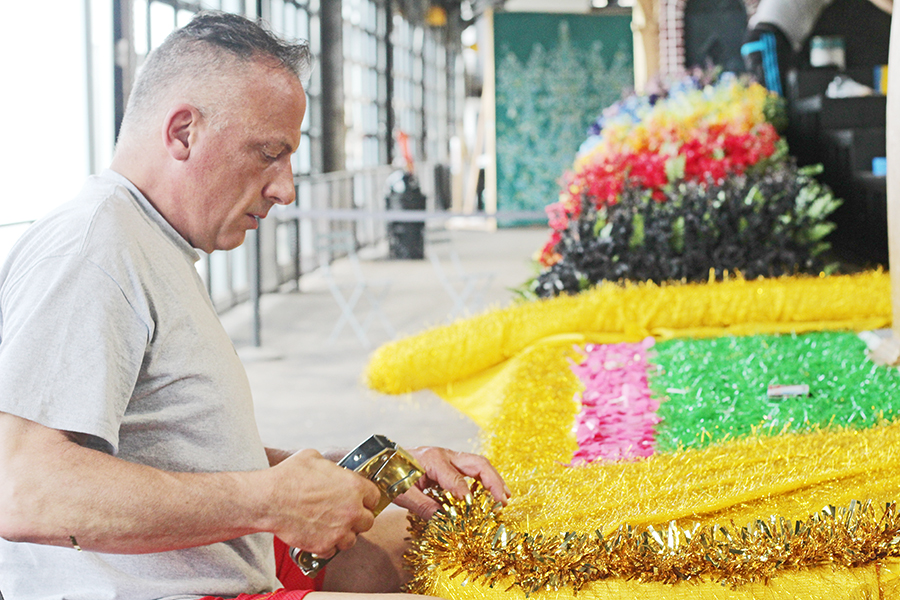A 34-foot-long float outfitted in a rainbow of thousands of flowers and more than a million golden fabric eyelashes will carry five Stonewall-era LGBTQ activists through Philadelphia’s Pride parade June 9.
The hand-painted “Philadelphia Pioneers on the Road to Stonewall” float commemorates the 50th anniversary of the Stonewall Riots. The featured activists will include Paul Kuntzler, John James, Randy Wicker and Mark Segal, who will ride alongside younger members of the LGBTQ community. Susan Silverman will likely appear as the fifth and, if unable, will be represented, said Segal.
The ambitious float stems from a partnership between LGBTQ philanthropy group Dr. Magnus Hirschfeld Fund, tourism agency VISIT PHILADELPHIA and city officials. It is the only float funded by community, city and state contributors.
“DmhFund wanted to inspire today’s LGBT youth to appreciate our community’s rich and radical history. Much of that history took place here in Philadelphia,” said Segal, dmhFund president and Philadelphia Gay News publisher. “We also wanted to set a new bar for Gay Pride and what it could mean in the future.”
A seven-foot replica of the Liberty Bell, crafted via 3D printing, marks the front of the float. At the back stands a replica of the historic Stonewall Inn facade, complete with a marquis sign designed after the original namesake from the 1970s. A picture frame surrounds the building as a nod to its historical significance, said Todd Marcocci, the president of event company Under The Sun Productions, Inc. who oversaw the float’s design.
A black-painted, plywood road runs down the float’s center, rising in five incremental levels. On either side of the road, the “Field of Honor,” made with thousands of artificial flowers spanning the colors of Philadelphia’s Pride flag, blossoms up to the base of the inn.

Todd Marcocci works on Pride history float. Photo: Laura Smythe
Marcocci attached each “Field of Honor” flower individually to the float — using 30 pounds of hot glue in the process.
“Every single [flower] is representing someone who has been bullied, somebody who has passed from AIDS, somebody that has HIV, somebody that’s been beaten, somebody that’s been murdered, somebody that is going through depression,” he said, noting the feature is his favorite of the project.
On June 8 from 12-3 p.m., people can stop by Cherry Street Pier to write messages on ribbons spanning the colors of the rainbow. They will be tied to the “Field of Honor” flowers to join the float on its journey through Philadelphia Pride, the New York City Pride March on June 30 and Philadelphia’s Salute to America Independence Day Parade on July 4.
The idea of “the power of five” informed Marcocci’s design vision, he said. An activist will stand on each of the road’s five levels, symbolizing the progress they enacted in each decade of the Stonewall era.
Paul Kuntzler, 77, was the 17th member of the Mattachine Society, one of the earliest LGBTQ organizations in the United States. He attended the Annual Reminders LGBTQ pickets at Independence Hall in 1965 and 1966.
Kuntzler said the Gertrude Stein Democratic Club, which represents the gay community in Washington, D.C., was founded in his living room in 1976. He also helped form the Gay Activists Alliance of Washington, D.C., today known as the nonprofit Gay and Lesbians Activists Alliance. It is the nation’s oldest continuously active LGBTQ organization, according to the Washington, D.C. Mayor’s Office of Lesbian, Gay, Bisexual, Transgender and Questioning Affairs.
The LGBTQ civil rights movement has a well-documented history in Philadelphia.
The nation’s first LGBTQ sit-in occurred at Dewey’s Diner, a now-defunct Center City eatery. Barbara Gittings, editor of the nation’s first lesbian magazine, called the city home and helped organize the Annual Reminders, which ran 1965-69.
While there is always room for improvement in LGBTQ rights, Kuntzler said he hopes younger LGBTQ people who see the float will gain a deeper understanding of the movement’s history.
“Looking back into the ’60s, we could never conceive of the astonishing progress that we made, that there would be laws to protect us against discrimination, that there would be openly gay officials in government,” Kuntzler said. “Most of all, we couldn’t conceive of the whole idea of marriage equality.”
Marcocci similarly hopes the float will help Pride attendees realize how LGBTQ history has impacted their lives.
“There are people who have made things happen throughout lifetimes prior to us that have then had an effect on our lifetimes,” he said. “In recognizing the individuals who will be riding on the float, I’m hoping people will be moved by their appearance on the float and then realize the impact that they personally can have in their [own] lifetime, just like the individuals riding it.”
For Segal, the float is “history on wheels.” DmhFund has been working on getting the project off the ground for 18 months, he said.
“I’m excited that a younger generation will get an opportunity to meet the person who was the first picketer for gay rights in 1965, another who demonstrated outside the White House in 1965, then those later who marched at Independence Hall,” Segal added. “And of course, Stonewall and Gay Liberation Front participants.”
Photo Credit: Laura Smythe
